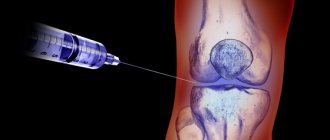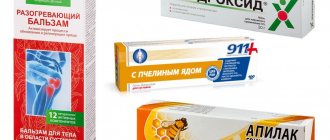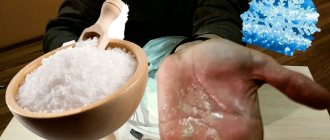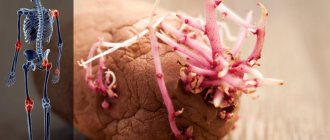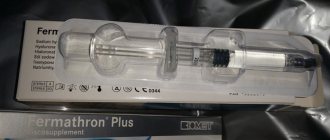Instructions for use
Protekon refers to drugs that are used for pathologies of the musculoskeletal system. Under the influence of active substances, the process of restoration of cartilage tissue is stimulated, and there is an analgesic and anti-inflammatory effect.
pharmachologic effect
contained in Protekon tablets acts as a substrate, which is necessary for the construction of articular cartilage . It is a stimulator of cartilage regeneration. After all, glycosaminoglycans and proteoglycans are components of the complex matrix of cartilage.
Glucosamine is part of the endogenous glycosaminoglycans of cartilage, stimulates the production of proteoglycans, and increases the absorption of sulfate by joint cartilage. It is involved in the process of biosynthesis of hyaluronic acid and proteoglycans. Thanks to this, it is possible to stop the degenerative processes occurring in the tissues of the joints, spine and soft tissues that surround it.
The medicine promotes the formation of hyaluronic acid
Under the influence of glucosamine, the formation of chondroitinsulfuric acid is stimulated, and the process of calcium deposition in bones is normalized. With long-term therapy, joint functions are restored and pain disappears.
which is part of Protekon, belongs to high molecular weight mucopolysaccharides . It has analgesic, chondroprotective and anti-inflammatory effects. Under the influence of chondroitin, the process of cartilage restoration is stimulated, phosphorus-calcium metabolism in tissues is normalized, and possible compression of connective tissues is prevented.
Chondroitin reduces the intensity of degenerative processes occurring in bone tissue, reduces calcium loss, and slows down the destruction of cartilage. When taken, the production of joint fluid is normalized, the articular surfaces are constantly “lubricated”.
Release form, composition
Protekon is available in the form of oval tablets for oral administration. They are biconvex, yellow, and have a notch on one side.
The main active ingredients are glucosamine sodium sulfate in terms of glucosamine sulfate 500 mg and chondroitin sulfate sodium 400 mg.
Indications for use
Protekon is prescribed to patients with:
- degenerative-dystrophic changes in the spine and joints;
- primary, secondary osteochondrosis;
- osteoarthrosis of various localizations (arthrosis of the knee, hip joints, spondyloarthrosis, etc.);
- humeroscapular periarthritis;
- chondromalacia kneecap.
Protekon is prescribed for degenerative diseases of the joints and spine
Tablets are prescribed to patients after fractures to speed up the process of callus formation.
Directions for use, dosage
The dosage of Protekon is selected for patients individually depending on the diagnosis . To stop the progression of osteoarthritis and prevent the process of destruction of articular cartilage, it is recommended to take 1 tablet three times a day during the first 3 weeks of treatment. Then the frequency of administration is reduced to 2 times a day, continuing to take 1 tablet per dose.
The standard duration of therapy is 2-3 months. It is recommended to repeat the course of treatment 2-3 times a year. But on the recommendation of doctors, continuous therapy is allowed for 3 years.
In most patients, the effect of taking the tablets appears after 1-1.5 months of treatment . In case of severe pain, you can combine Protekon and analgesics.
Interaction with other drugs
The patient should notify the physician about taking other medications to evaluate drug interactions.:
Please note what the drug can and cannot be used with: combination with fibrinolytics, antiplatelet agents, indirect coagulants leads to an increase in their effect, it is necessary to monitor the functioning of the blood coagulation system;- combination with corticosteroids and NSAIDs leads to a decrease in the need for these medications and painkillers;
- combination therapy leads to an increase in the absorption of tetracycline drugs and a decrease in the absorption of penicillins and chloramphenicol.
To increase the effectiveness of treatment with Protekon, it is recommended to enrich the diet with vitamins C, A, selenium salts, zinc, copper, magnesium, manganese.
Coronavirus 200 mg 50 pcs. film-coated tablets
pharmachologic effect
Antiviral agent.
Composition and release form Coronavirus 200 mg 50 pcs. film-coated tablets
Tablets - 1 tablet:
- Active ingredient: favipiravir – 200.0 mg;
- Excipients: microcrystalline cellulose 101, colloidal silicon dioxide, povidone-K25, crospovidone, sodium stearyl fumarate;
- Film shell: Opadry II 85F220031 yellow [polyvinyl alcohol, titanium dioxide, macrogol 4000, talc, iron oxide yellow].
Film-coated tablets, 200 mg.
50 tablets per polymer jar (made of polyethylene) for medicines, sealed with a polymer lid (made of polypropylene) with first opening control.
A label made of label or writing paper or a self-adhesive label is glued onto the jar.
Each jar, along with instructions for use, is placed in a box made of cardboard.
Description of the dosage form
The tablets are round, biconvex, film-coated, light yellow with a brownish tint. In cross section, the tablet core is white to light yellow.
Directions for use and doses
Inside, 30 minutes before meals.
The drug CORONAVIR is prescribed in a hospital setting.
For the treatment of a new coronavirus infection caused by the SARS-CoV-2 virus (COVID-19), the following dosage regimen is used: 1800 mg 2 times a day on the 1st day of therapy, then 800 mg 2 times a day from the 2nd on the 10th day of therapy.
The total duration of treatment is 10 days or until confirmation of viral elimination, if earlier (2 consecutive negative PCR test results obtained at least 24 hours apart).
Pharmacodynamics
Antiviral activity in vitro
Favipiravir has antiviral activity against laboratory strains of influenza A and B viruses (half maximum effective concentration (EC50) 0.014-0.55 μg/ml).
For strains of influenza A and B viruses resistant to adamantane (amantadine and rimantadine), oseltamivir or zanamivir, the EC50 is 0.03-0.94 µg/ml and 0.09-0.83 µg/ml, respectively. For influenza A virus strains (including strains resistant to adamantane, oseltamivir and zanamivir), such as swine influenza type A and avian influenza type A, including highly pathogenic strains (including H5N1 and H7N9), the EC50 is 0.06-3. 53 mcg/ml.
For strains of influenza A and B viruses resistant to adamantane, oseltamivir and zanamivir, EC50 is 0.09-0.47 μg/ml; cross-resistance is not observed.
Favipiravir inhibits the SARS-CoV-2 virus, which causes novel coronavirus disease (COVID-19). The EC50 in Vero E6 cells is 61.88 µmol, which corresponds to 9.72 µg/ml.
Mechanism of action
Favipiravir is metabolized in cells to favipiravir ribosyltriphosphate (favipiravir RTP) and selectively inhibits RNA-dependent RNA polymerase involved in influenza virus replication. Favipiravir RTF (1000 µmol/L) did not show an inhibitory effect on human α DNA, but showed an inhibitory effect ranging from 9.1 to 13.5% on β and in the range from 11.7 to 41.2% on γ DNA person. The inhibitory concentration (IC50) of favipiravir PTF for human RNA polymerase II was 905 μmol/L.
Resistance
After 30 subcultures in the presence of favipiravir, no changes were observed in the susceptibility of influenza A viruses to favipiravir, and no resistant strains were observed. Clinical studies have not revealed the emergence of influenza viruses resistant to favipiravir.
Pharmacokinetics
Suction
Favipiravir is easily absorbed from the gastrointestinal tract. Time to reach maximum concentration (Tmax) – 1.5 hours.
Distribution
Plasma protein binding is about 54%.
Metabolism
Favipiravir is primarily metabolized by aldehyde oxidase and partially metabolized to its hydroxylated form by xanthine oxidase. Favipiravir RTF is metabolized in cells. Of the other metabolites, in addition to hydroxylate, glucuronate conjugate was also recorded in human blood plasma and urine.
Removal
Favipiravir is mainly excreted by the kidneys as the active hydroxylate metabolite, with a small amount unchanged. The half-life (T1/2) is about 5 hours.
Patients with liver dysfunction
When favipiravir was taken by patients with mild to moderate hepatic impairment (Child-Pugh classes A and B), the increase in Cmax and AUC was 1.5 and 1.8 times, respectively, compared with healthy volunteers. These increases in Cmax and AUC for patients with severe hepatic impairment (Child-Pugh class C) were 2.1 and 6.3 times, respectively.
Patients with impaired renal function
In patients with moderate renal failure (GFR
Indications for use Coronavirus 200 mg 50 pcs. film-coated tablets
Treatment of new coronavirus infection (COVID-19).
Contraindications
Hypersensitivity to favipiravir or any component of the drug CORONAVIR.
Severe liver failure (class C according to the Child-Pugh classification).
Severe and terminal renal failure (GFR)
Pregnancy or planning pregnancy.
Breastfeeding period.
Children under 18 years of age.
Carefully
In patients with a history of gout and hyperuricemia (possibly increased uric acid levels in the blood and exacerbation of symptoms), in elderly patients with mild to moderate hepatic impairment (Child-Pugh classes A and B), in patients with moderate renal impairment severity (GFR
Application of Coronavirus 200 mg 50 pcs. film-coated tablets during pregnancy and breastfeeding
Early embryonic lethality and teratogenicity were observed in preclinical studies of favipiravir at doses similar to or lower than clinical doses.
The drug CORONAVIR is contraindicated in pregnant women, as well as in men and women planning pregnancy. When prescribing CORONAVIR to women capable of childbearing (including those less than 2 years postmenopausal), it is necessary to confirm a negative pregnancy test result before starting treatment. A repeat pregnancy test must be performed after stopping the drug. It is necessary to use effective methods of contraception (condom with spermicide) while taking the drug and after its completion: for 1 month for women and for 3 months for men.
When prescribing CORONAVIR, nursing women must stop breastfeeding while taking the drug and for 7 days after finishing it, since the main metabolite of favipiravir passes into breast milk.
special instructions
The use of the drug CORONAVIR is possible only in inpatient medical care.
If a side effect develops, it is necessary to report this in the prescribed manner for the implementation of pharmacovigilance activities.
Before starting to take the drug CORONAVIR, the patient must be provided with written information about the effectiveness of the drug and the risks associated with its use (including the risk of effects on the embryo and fetus), and obtain written consent to use the drug.
Because fetal death and teratogenicity were observed in animal studies of favipiravir, CORONAVIR should not be administered to pregnant or suspected pregnant women.
When prescribing CORONAVIR to women capable of childbearing (including those less than 2 years postmenopausal), it is necessary to confirm a negative pregnancy test result before starting treatment. Women of childbearing potential should be fully explained the risks and carefully instructed to use the most effective method of contraception with their partners while taking the drug and for 1 month afterwards (condom with spermicide). If you suspect a possible pregnancy, you should immediately stop taking the drug and consult your doctor.
When distributed in the human body, the drug CORONAVIR enters the semen. When prescribing the drug, male patients must be fully explained the risks and carefully instructed to use the most effective methods of contraception during sexual intercourse while taking the drug and for 3 months after its end (condom with spermicide). Additionally, male patients should be instructed not to have sexual contact with pregnant women.
When distributed in the human body, the drug CORONAVIR passes into breast milk. When prescribing the drug, breastfeeding women should be fully explained the risks and carefully instructed to stop breastfeeding while taking the drug and for 7 days after it ends.
Impact on the ability to drive vehicles and operate machinery
Care should be taken when driving vehicles and operating machinery.
Overdose
There are no reports of overdose with favipiravir.
Side effects Coronavirus 200 mg 50 pcs. film-coated tablets
In a clinical trial of the drug CORONAVIR, adverse reactions were observed in 29 patients out of 37 (78.4%), including: hyperuricemia (in 23 patients (62.2%)), increased ALT (in 8 patients (21.6%)) , increased AST (in 6 patients (16.2%)), diarrhea (in 7 patients (18.9%)), increased creatine kinase (in 5 patients (13.5%)), hyperglycemia (in 4 patients (10. 8%)), nausea (in 2 patients (5.4%)), epigastric pain (in 2 patients (5.4%)), increased LDH (in 1 patient (2.7%)), increased ferritin levels (in 1 patient (2.7%)), skin rash (in 2 patients (5.4%)), increased sweating of the feet (in 1 patient (2.7%)), chilliness of the feet (in 1 patient (2.7%) 7%)), headache (in 1 patient (2.7%)), arm weakness (in 1 patient (2.7%)), hematuria (in 1 patient (2.7%)).
Adverse reactions observed in clinical trials in patients with influenza infection (analyzed in the pooled safety population) are presented in Table 1.
The assessment of the incidence of adverse reactions is based on the WHO classification: very often (≥1/10); often (≥1/100,
From the blood and lymphatic system: often - neutropenia, leukopenia; rarely - leukocytosis, monocytosis, reticulocytopenia.
Metabolism: often - hyperuricemia, hypertriglyceridemia; uncommon - glucosuria; rarely - hypokalemia.
From the immune system: infrequently - rash; rarely - eczema, itching.
From the respiratory system: rarely - bronchial asthma, sore throat, rhinitis, nasopharyngitis.
From the digestive system: often - diarrhea; uncommon - nausea, vomiting, abdominal pain; rarely - abdominal discomfort, duodenal ulcer, bloody stools, gastritis.
From the liver and biliary tract: often - increased activity of ALT, AST, GGT; rarely - increased alkaline phosphatase activity, increased bilirubin concentration in the blood.
Other: rarely - abnormal behavior, increased CPK activity, hematuria, laryngeal polyp, hyperpigmentation, impaired taste sensitivity, hematoma, blurred vision, eye pain, vertigo, supraventricular extrasystoles, chest pain.
Drug interactions
The drug CORONAVIR is not metabolized by cytochrome P450, mainly metabolized by aldehyde oxidase and partially metabolized by xanthine oxidase. The drug CORONAVIR inhibits aldehyde oxidase and cytochrome CYP2C8, but does not induce cytochrome P450.
When used concomitantly with pyrazinamide, hyperuricemia occurs due to an additional increase in the reabsorption of uric acid in the renal tubules.
When used simultaneously with repaglinide, it is possible to increase the concentration of repaglinide in the blood and develop undesirable reactions caused by the action of repaglinide.
When used simultaneously with famciclovir and sulindac, their effectiveness may decrease due to favipiravir inhibition of aldehyde oxidase, which can lead to a decrease in the concentration of active forms of these substances in the blood.
Side effects
Before taking it, it is advisable to familiarize yourself with the list of complications that may arise during therapy.
| From the nervous system the following may appear: |
|
| From the digestive system, some patients experience: |
|
| On the part of the immune system , subcutaneous tissue, and skin, there is a possibility of developing: |
|
Some people experience swelling. All side effects disappear immediately after stopping treatment.
Overdose
Did you know that...
Next fact
There is no information on overdose with Protekon. In such cases, increased side effects may occur. In case of overdose, symptomatic therapy is prescribed.
Contraindications
Protekon is not prescribed to patients who have:
- hypersensitivity to the components of the product;
- increased tendency to bleed;
- thrombophlebitis;
- renal and liver failure in the stage of decompensation;
- diabetes;
- phenylketonuria.
Before prescribing treatment, it is necessary to warn the doctor about existing diseases.
During pregnancy and lactation
The period of pregnancy and lactation is included in the list of contraindications for use . The safety and effectiveness of the product have not been studied during these periods. If treatment is necessary, stop breastfeeding.
Video: “Instructions for the drug Protekon”
Coaprovel tablets 300 mg+25 mg 28 pcs.
Coaprovel is a combination of an angiotensin II receptor antagonist, irbesartan, and a thiazide diuretic, hydrochlorothiazide. The combination of these ingredients has an additive antihypertensive effect, lowering blood pressure to a greater extent than either ingredient alone. Irbesartan is a selective antagonist of angiotensin II receptors (AT1 type). Irbesartan does not require metabolic activation to acquire pharmacological activity. Angiotensin II is an important component of the renin-angiotensin-aldosterone system (RAAS) and is involved in the pathogenesis of arterial hypertension, as well as sodium homeostasis. Irbesartan blocks all physiologically significant effects of angiotensin II, regardless of the source or route of its synthesis, including its strongly expressed vasoconstrictor and aldosterone-secreting effects, realized through AT1 type receptors located on the surface of vascular smooth muscle cells and in the adrenal cortex. It does not have agonistic activity towards AT1 receptors and has a much greater (more than 8500 times) affinity for AT1 receptors than for AT2 receptors (receptors not associated with the regulation of the cardiovascular system). Irbesartan does not inhibit RAAS enzymes (such as renin, angiotensin-converting enzyme [ACE]) and does not affect other hormone receptors or ion channels involved in the regulation of blood pressure (BP) and sodium homeostasis. Blocking AT1 receptors with irbesartan interrupts the feedback chain in the renin-angiotensin system, which leads to an increase in the concentration of renin and angiotensin II in the blood plasma. After taking irbesartan in recommended doses, the plasma concentration of aldosterone decreases, without having a significant effect on the content of potassium in the blood serum (the average increase is <0.1 mEq/L). Irbesartan has no significant effect on serum concentrations of triglycerides, cholesterol and glucose. Irbesartan does not affect the concentration of uric acid in the blood serum or the rate of excretion of uric acid by the kidneys. Hydrochlorothiazide is a thiazide diuretic with diuretic, natriuretic and antihypertensive effects. The mechanism of the antihypertensive effect of thiazide diuretics, such as hydrochlorothiazide, is not fully known. Thiazide diuretics affect the tubular mechanisms of reabsorption of electrolytes in the kidneys, approximately equally increasing the excretion of sodium and chloride. Natriuresis leads to secondary loss of potassium and bicarbonate. Hydrochlorothiazide increases plasma renin activity and aldosterone secretion, and also reduces serum potassium levels. Concomitant use of an angiotensin II receptor antagonist helps reduce potassium losses associated with the action of thiazide diuretics. The antihypertensive effect of irbesartan in combination with hydrochlorothiazide appears after taking its first dose and becomes significant within 1-2 weeks of administration, its maximum antihypertensive effect is achieved by 6-8 weeks of treatment. In long-term clinical studies, the antihypertensive effect of the irbesartan/hydrochlorothiazide combination was observed to persist for more than one year. The combination of hydrochlorothiazide/irbesartan, when taken in the therapeutic dose range, has a dose-dependent and additive antihypertensive effect. In patients who did not experience a sufficient reduction in blood pressure during monotherapy with irbesartan at a dose of 300 mg, the addition of 12.5 mg of hydrochlorothiazide once a day to monotherapy with irbesartan at a dose of 300 mg once daily led to an additional decrease in diastolic blood pressure at the end of the interdose period. interval (i.e., 24 hours after taking the drugs) by 6.1 mmHg. Art. (compared to adding placebo). There was an overall reduction in systolic blood pressure (SBP)/diastolic blood pressure (DBP) with the combination of 300 mg irbesartan and 12.5 mg hydrochlorothiazide (compared to placebo) to -13.6/-11.5 mmHg. Art. A single daily dose of 150 mg of irbesartan and 12.5 mg of hydrochlorothiazide demonstrated (compared to placebo) an average decrease in SBP/DBP at the end of the interdose interval by 12.9/6.9 mm Hg. Art., respectively. The maximum antihypertensive effects developed after 3-6 hours. With 24-hour blood pressure monitoring, taking Coaprovel 12.5/150 mg once a day caused a stable decrease in blood pressure during the day (the average decrease in SBP/DBP was -15.8/-, respectively) 10.0 mm Hg compared to placebo). Expressed as a percentage, T/P rates (the ratio of blood pressure measured at the end of the interdose interval [residual effect] to blood pressure at the time of maximum effect of irbesartan/hydrochlorothiazide combinations) were at least 68%. In a clinical study in patients with insufficient blood pressure reduction during hydrochlorothiazide monotherapy at a dose of 25 mg, the addition of irbesartan to hydrochlorothiazide caused an additional mean reduction in SBP/DBP by 11.1/7.2 mm Hg. Art., respectively, compared with monotherapy with hydrochlorothiazide. Blood pressure decreased to the same extent in the standing and lying positions. Orthostatic effects have been observed rarely, but may occur in patients with hyponatremia and/or hypovolemia. The effectiveness of irbesartan/hydrochlorothiazide does not depend on age, race or gender. The overall antihypertensive response to the combination was similar in black patients and patients of other races. After discontinuation of irbesartan, blood pressure gradually returned to initial values. No withdrawal syndrome was observed for irbesartan and hydrochlorothiazide. When hydrochlorothiazide is taken orally, the diuretic effect occurs within the first 2 hours, diuresis reaches a maximum after approximately 4 hours and persists for approximately 6-12 hours. Two clinical studies evaluated treatment with Coaprovel as initial therapy in patients with moderate (initial mean blood pressure) 162/98 mm Hg) and severe (initial mean blood pressure 172/113 mm Hg) arterial hypertension. Both studies showed a significant advantage in the antihypertensive effect of Coaprovel (in doses from 12.5/150 mg to 25/300 mg) as initial therapy, compared with the use of irbesartan monotherapy (in doses from 150 mg to 300 mg) as initial therapy. mg) and hydrochlorothiazide (in doses from 12.5 mg to 25 mg).
special instructions
When treated with Protekon and the presence of asthma, exacerbations of the disease are possible. When treated with Protekon, taking the drug in increased doses is not advisable, this does not increase the effectiveness of therapy.
It is possible to prescribe Protekon as part of complex therapy in combination with non-steroidal anti-inflammatory drugs and glucocotic steroids.
Patients with bronchial asthma are advised to exercise caution during treatment.
The condition may worsen and the symptoms of the disease may worsen.
If therapy with Protekon is necessary, constant monitoring of the condition is carried out in order to timely detect an increase in asthmatic symptoms.
Effect on concentration
Special studies assessing the ability to continue to drive vehicles and operate complex machinery during Protekon therapy have not been conducted. Patients who experience drowsiness, dizziness, or increased fatigue when taking tablets should stop driving cars and operating machinery.
In case of kidney and liver dysfunction
In case of renal and liver failure in the stage of decompensation, the use of the drug is prohibited. For other disorders of the liver and kidneys, the drug is used with caution.
Use in childhood
The drug is not used in pediatrics.
Doctor's review
Alexander Pichugin Doctor of the highest category,
“Protekon can be used regularly and seasonally; it has an effect on allergic manifestations and the causes that caused them. The first cases of using the drug can eliminate tearfulness, swelling, runny nose, relieve nasal congestion, itching on the skin and rashes, attacks of asthmatic cough and shortness of breath. To protect yourself from allergic manifestations during the allergy season, you need to use this drug as a course. As an additional bonus, this product has the effect of increasing performance and improving the general condition of the body, removing toxins and poisons, increasing immune capabilities and restoring metabolic reactions. The certificates obtained by the drug as a result of clinical testing fully confirm its compliance.”
Analogs
There are many analogues of Protekon in pharmacies. But it is better to replace tablets in consultation with your doctor.
The most popular are such analogues:
- Artron Triactive forte;
- Flex-A-Min;
- Osteoartisi Active Plus;
- Sanaflex;
- Teraflex;
- Chondroitin complex;
- Chondro-Ritz.
The doctor may also prescribe medications in the production of which not chondyroitin and glucosamine sulfate were used, but other active ingredients. You can select drugs made on the basis of plant components, bone marrow extract and cartilage of young cattle, sea fish extract with germaben, hyaluronic acid .
Reviews
Protekon eliminates joint pain. You can evaluate the effectiveness of Protekon if you read the reviews of patients who took it.
People note that treatment reduces joint pain , including those that occurred after intense physical activity.
After completing the course of therapy, the discomfort that arose in the joints when the weather changed ceased to bother me. For some, the effect becomes noticeable already in the first week of treatment.
If you have had experience using Protekon, share your opinion about the tablets with other patients. This will allow you to understand whether it is worth buying pills and whether your condition will improve after completing the course of therapy.

